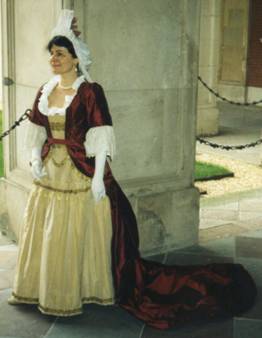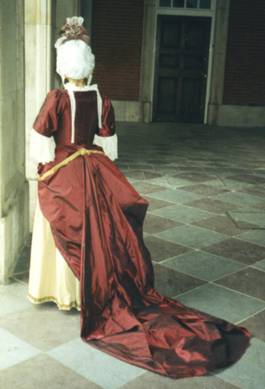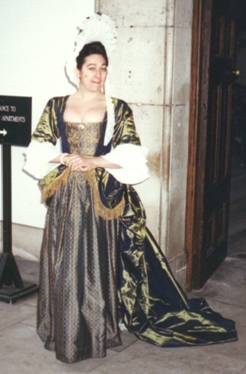
Mantua Gowns c. 1700
I made a series of outfits of circa 1700 for use in the William and Mary apartments at Hampton Court Palace, London.
Each outfit comprised:
Shift, Stays, Rump (bustle), Linen petticoat, Silk petticoat, Mantua gown, Stomacher and Fontange head-dress.
The dresses were worn by professional historical interpreters who led tours and gave special presentations about aspects of life in the Palace around the year 1700.
The Mantua has its origins in the late 17th Century when it was an informal garment cut from straight widths of fabric in a 'T' shape. By the end of the century it had become acceptable dress for almost all functions and during the early 18th century fossilised into a formal court costume.
 The style is characterised by vertical pleats fitting the fabric to the wearer's back and then continuing into the skirt. The dresses shown had long trains to denote the wearer's position in society.
Only the rich could afford to destroy fabric by trailing it over the ground. Middle or working class women would either not have a train or have a very short one that could be pinned up out of the way when working.
The style is characterised by vertical pleats fitting the fabric to the wearer's back and then continuing into the skirt. The dresses shown had long trains to denote the wearer's position in society.
Only the rich could afford to destroy fabric by trailing it over the ground. Middle or working class women would either not have a train or have a very short one that could be pinned up out of the way when working.
 The tall Fontange head-dress was a French fashion that gained popularity all over Europe. It was ridiculed for being so tall that a woman's head became the middle of her body instead of the top and could be very dangerous near candles.
The tall Fontange head-dress was a French fashion that gained popularity all over Europe. It was ridiculed for being so tall that a woman's head became the middle of her body instead of the top and could be very dangerous near candles.
Wearing an elaborate Fontange was a mark of great wealth and status since it was normally made of lace which might cost several times a working man's yearly wage. The style also involved a lot of skill on the part of the laundry maid. To dismantle, wash, starch, re-pleat, dry and arrange the frills for the examples shown used to occupy me for an entire day for each head-dress.
